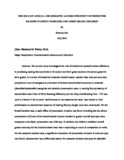The role of lexical and semantic access efficiency in predicting reading fluency in second and third grade children.
Author
Gee, Brittney
Abstract
The present study investigated the role of lexical and semantic access efficiency in predicting reading fluency levels in 32 second and third grade students (16 second grade/16 third grade). In a series of lexical and semantic decision tasks, reaction time (ms) and accuracy (proportion) were investigated as a function of lexical (nouns/verbs/nonwords) or semantic (plausible/implausible) categories and stimulus presentation rates. A reading fluency battery of standardized tests (Test of Word Reading Efficiency and the Gray Oral Reading Test – IV) was used to observe if the students‘ performance on the experimental tasks was related to their performance on standardized measures of reading fluency (single-word and contextual). For the lexical decision task, a main effect of presentation duration was found revealing that the slower presentation (350 ms) of the lexical stimuli (words) resulted in greater overall accuracy when compared to the faster presentation rate (100 ms). In addition, the children exhibited overall greater accuracy for the lexical decision task when responding to nouns in comparison to verbs. For the semantic decision task, a significant interaction of presentation duration X sentence type was found, characterized by a differential pattern for semantic decision accuracy for plausible sentences as a function of stimulus presentation duration. Accuracy for plausible sentences was higher for the longer presentation duration (1000 ms) and lower for the faster presentation duration (300 ms). The accuracy for the implausible sentences was not differentially affected by the two presentation duration rates.
Additional findings revealed significant correlations between standard scores on the Gray Oral Reading Test-4th Edition (Fluency Composite), the Test of Word Reading Efficiency (Total Word Reading Efficiency), and the reaction time data for both the lexical and semantic decision experimental tasks. Significant correlations were also revealed between standardized measures on the GORT-IV and TOWRE when correlated to decoding accuracy for both experimental tasks. These findings may suggest that lexical and semantic access efficiency serve as important underlying correlates when accounting for the variance in the development of reading fluency in second and third grade children. In addition, these findings support the notion that children at the developing fluency grade levels may need more time to process, comprehend and respond when decoding and comprehending text, while reading fluency is in the early stages of development.
Date
2011
Citation:
APA:
Gee, Brittney.
(January 2011).
The role of lexical and semantic access efficiency in predicting reading fluency in second and third grade children.
(Master's Thesis, East Carolina University). Retrieved from the Scholarship.
(http://hdl.handle.net/10342/3678.)
MLA:
Gee, Brittney.
The role of lexical and semantic access efficiency in predicting reading fluency in second and third grade children..
Master's Thesis. East Carolina University,
January 2011. The Scholarship.
http://hdl.handle.net/10342/3678.
June 29, 2024.
Chicago:
Gee, Brittney,
“The role of lexical and semantic access efficiency in predicting reading fluency in second and third grade children.”
(Master's Thesis., East Carolina University,
January 2011).
AMA:
Gee, Brittney.
The role of lexical and semantic access efficiency in predicting reading fluency in second and third grade children.
[Master's Thesis]. Greenville, NC: East Carolina University;
January 2011.
Collections
Publisher
East Carolina University

